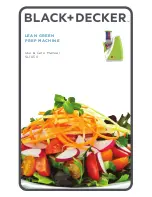
10
9
Before you do anything, wait for the blade
to stop spinning. Once it does, turn the cover
clockwise to unlock, and remove by lifting
it off.
Remove the bowl from the base of the machine
before removing the blade. This creates a seal
to prevent food from leaking. Turn the bowl
clockwise to unlock from the base, and lift
straight up to remove.
To prevent the blade from falling from the work
bowl onto your hand when emptying the work
bowl, use one of the following methods:
Be sure your hands are dry. Grab the blade
hub, and remove the metal blade before
tilting the bowl, using a spatula to scrape off
any food. Then carefully lift the blade out of
the work bowl. Or insert your finger through
the hole in the bottom of the work bowl,
gripping the blade from the bottom, and
grip the outside of the work bowl with your
thumb. Or hold the blade in place with your
finger or spatula while pouring out food.
TECHNIQUES FOR
CHOPPING, MIXING AND
PURÉEING WITH THE METAL
BLADE
To chop raw fruits and vegetables:
First, cut the food into 1-inch (2.5 cm) pieces.
You get a more even chop when all pieces are
about the same size.
Put no more than the recommended amount
of food into the work bowl (see table inside
front cover). Lock the cover in place. Press the
PULSE button at the rate of
1 second on, 1 second off, until the food is
coarsely chopped. For more finely chopped
results, hold the PULSE button, letting the
machine run continuously until the desired
consistency is reached. Check frequently to
avoid overprocessing. Use the spatula
to scrape down the sides of the work bowl
if necessary.
To purée fruits and cooked vegetables:
First, cut the food into 1-inch (2.5 cm) pieces.
You get a smoother purée faster when all pieces
are about equal in size.
Put no more than the recommended amount
of food in the work bowl (see table inside front
cover). Lock the cover in place. PULSE to chop
coarsely, then press the ON button and process
continuously until food is puréed. (
NOTE:
Cooked potatoes are an exception to this
procedure. They develop a gluey texture when
processed with the metal blade.)
When making soup, you will want to purée
vegetables that have been cooked in liquid.
Don’t add the liquid to the work bowl, add just
the cooked vegetables; remove vegetables
with a slotted spoon. They will purée faster and
smoother without liquid. Then add just enough
liquid to make the purée pourable. Return to the
soup liquid and stir to combine.
To dislodge food:
Occasionally, a piece of food may become
wedged between the blade and the work bowl.
If this happens, unplug the machine, remove
the cover, lift the blade out carefully and remove
the wedged piece. Empty the bowl, reinsert the
blade and lock the cover and pusher into place.
Press the ON button and drop the food pieces
through the small feed tube opening while the
machine is running. After adding a cupful this
way, add the remaining food to the bowl and
process in the usual manner.
To chop hard foods:
To chop hard food like garlic and hard cheese,
assemble the unit, remove the small pusher,
press the ON button and drop the food through
the small feed tube while the machine is
running.
Small foods like garlic can be dropped in whole.
Large foods like hard cheese should be cut
into 1-inch (2.5 cm) pieces. This method of
processing minces garlic, shallots and onions.
Hard cheese and coconut will have the same
texture as if they had been hand grated.
IMPORTANT:
Never try to process cheese that
is too hard to cut with a knife. You may damage
the blade or the machine.
To chop parsley and other fresh herbs:
The herbs, the work bowl and the metal
chopping blade must all be thoroughly clean
and dry. Remove stems from herbs.
Add leaves to bowl and process, using the
PULSE button, until chopped as fine as desired.
The more herbs you chop at a time, the finer
chop you can obtain. If completely dry when
chopped, parsley and other herbs will keep for
at least 4–5 days, stored in an airtight bag in
the refrigerator. They may be frozen for months,
stored in an airtight container or bag.
To chop peel from citrus fruit or to chop
sticky fruit like dates or raisins:
For citrus, remove only the peel with vegetable
peeler, not the white pith, which is bitter-tasting.
Cut the peel into lengths of 2 inches (5 cm)
or less and process with ½ cup (125 ml) of
granulated sugar until finely chopped. This may
take 2 minutes or longer.
For sticky fruit like dates, raisins, prunes and
candied fruit,
first freeze the fruit for about
10 minutes. Add some of the flour called for in
the recipe to the fruit. Use no more than 1 cup
(250 ml) of flour for each cup of fruit.
To chop meat, poultry, fish and seafood:
The food should be very cold, but not frozen.
Cut it into 1-inch (2.5 cm) pieces to ensure an
even chop. Using the ON button, process no
more than the recommended amount at one
time (see table inside front cover). Press the
PULSE button 3 or 4 times at a rate of 1 second
on, 1 second off. If the food is not chopped fine
enough, let the processor run continuously for a
few seconds.
Check the texture often to avoid overprocessing.
Use a spatula to scrape food from the sides of
the bowl as necessary.
To purée meat, poultry, fish and seafood:
Prepare the food as described above. Press
the PULSE button until evenly chopped, then
process continuously to the desired texture.
Scrape the bowl with a spatula as needed.
Leave the purée in the work bowl and add eggs,
cream and seasonings as called for by the
recipe. Process to combine thoroughly.
Remember, you control texture by the length
of time you process. By varying the processing
time, you can get a range of textures suitable for
hamburgers, hash, stuffed peppers, or smooth
mousses.
To chop nuts
:
Chop no more than the recommended amount
at one time. Press and release the PULSE
button and check frequently to avoid nuts
clumping together in a nut butter. When a recipe
calls for flour or sugar, add some to the nuts
before you chop, about ½ cup (125 ml) for each
cup of nuts. This allows you to chop the nuts
as fine as you want without turning them into
a nut butter. You can also chop nuts with a
shredding disc. The optional fine shredding disc
is particularly good.
To make peanut butter
and other nut butters:
Process up to the recommended amount
of nuts. Using the ON button, let the machine
run continuously. After 2 or 3 minutes, the
ground nuts will form a ball that will gradually
smooth out. Scrape the sides of the bowl
and continue processing until drops of oil are
visible. Taste for consistency. The longer you
process, the softer the butter. For chunk style,
add a handful of nuts just after the ball of nut
butter begins to smooth out. To make cashew
butter, add a little bland vegetable oil. Processor
nut butters contain no preservatives. Store in
refrigerator to prevent separating.
To make flavoured butters,
spreads and dips:
Cut room-temperature butter into tablespoon-
size pieces. Finely chop flavouring ingredients
first, such as anchovies, cheese, herbs, etc.
Be sure work bowl is clean and dry. Add small
hard ingredients like garlic and hard cheese
through the feed tube while machine is running.
Next, add the butter and process using the ON
button, until smooth. Add any liquid ingredients
last, while the processor is running, and process
just long enough to blend. Process ingredients
for spreads and dips the same way. They should
be at room temperature and cut into 1-inch
(2.5 cm) cubes, or added by tablespoonfuls.
To make mayonnaise:
You can make foolproof homemade mayonnaise
with your Premier Series 11 Cup (2.6 L) Food
Processor. The work bowl and metal blade
must be clean and dry. Use the metal blade
to process eggs (for safe food procedures, we
recommend using pasteurized liquid eggs), salt,
vinegar or lemon juice, dry mustard, and two
tablespoons of the oil until smooth, at least 30
seconds. With the machine running, pour ¼ cup
(60 ml) of the oil into the small pusher. After
it dribbles through the pinhole in the bottom,
remove the small pusher and very slowly add







































